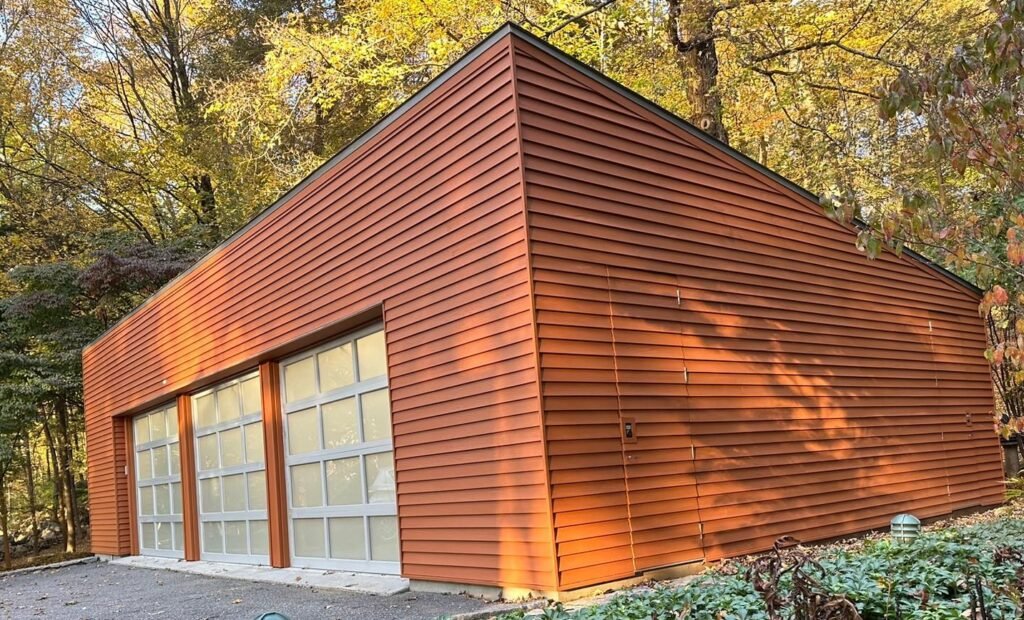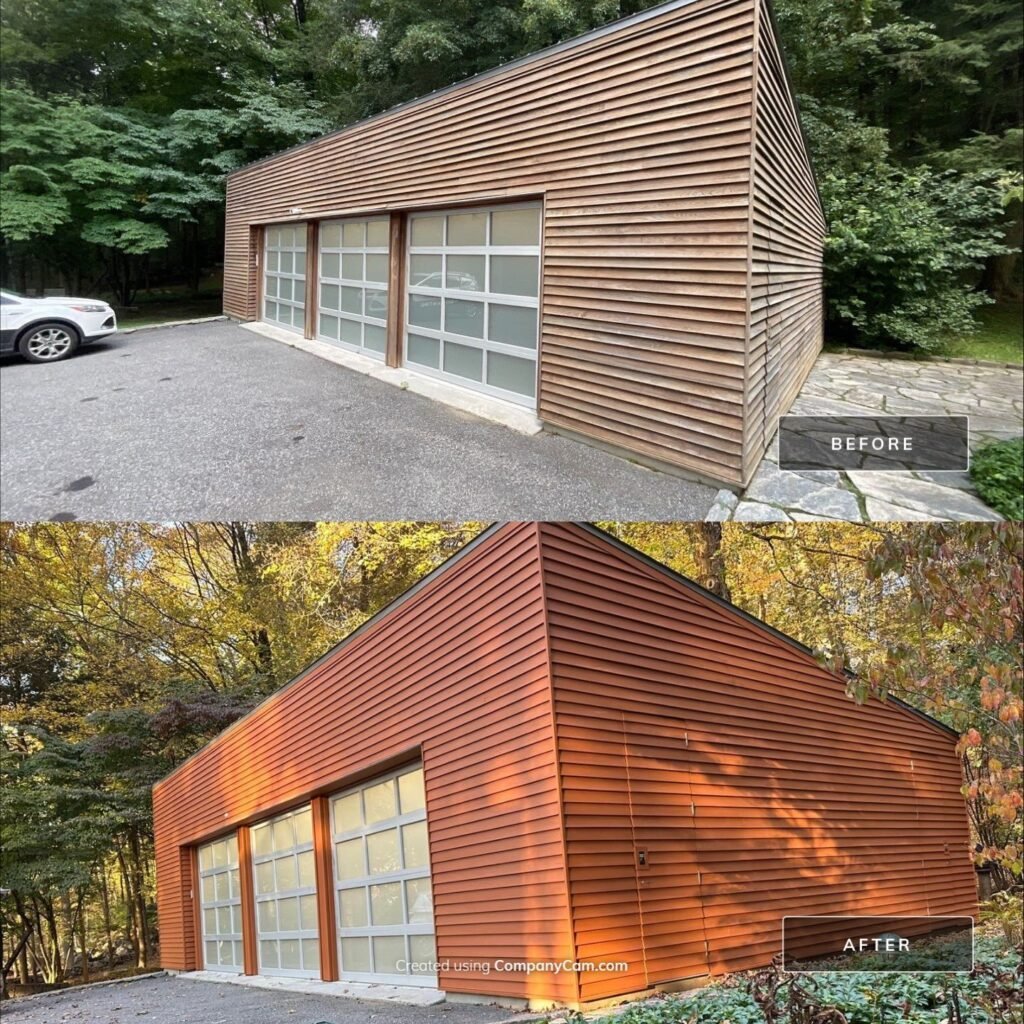Metal buildings, from industrial warehouses and commercial storefronts to agricultural barns and personal workshops, offer exceptional durability and versatility. However, like any exterior surface, their paint finish will eventually fade, chip, or show signs of rust due to constant exposure to the elements. Repainting a metal building is a highly effective way to restore its appearance, enhance its curb appeal, and extend its protective lifespan. In Chappaqua, NY, Genesis Pro Painting provides professional expertise in repainting metal structures, ensuring a long-lasting and high-quality finish.

Preparation steps
Proper surface preparation is the most critical factor for a successful and durable paint job on a metal building. Skipping or rushing these steps will inevitably lead to premature paint failure, such as peeling, blistering, or rust breakthrough.
- Thorough Cleaning and Degreasing:
- Remove All Contaminants: Metal surfaces accumulate dirt, grime, grease, oil, and chalking (a powdery residue from old, failing paint). All of this must be removed for the new paint to adhere properly.
- Washing: For large metal buildings, power washing is often the most efficient method. Use a low to medium pressure (below 2500 psi) to avoid damaging the metal. For stubborn areas, use a mild detergent solution or a specialized degreaser (like TSP substitute).
- Rinsing: Rinse the entire surface thoroughly with clean water to remove all cleaning solution residue. Any lingering residue can interfere with paint adhesion.
- Drying: Allow the metal surface to dry completely before proceeding. This can take 24-48 hours, especially in humid conditions. Any trapped moisture will cause paint adhesion issues.
- Rust and Loose Paint Removal:
- Scraping and Wire Brushing: Use wire brushes, scrapers, or a wire wheel attachment on a drill to remove all loose, flaking, or peeling paint and any visible rust. This creates a stable surface.
- Sanding: Sand all areas where rust was removed or where old paint was scraped to feather the edges and create a smooth profile. Use a medium-grit (e.g., 80-120 grit) sandpaper to scuff the surface for better primer adhesion. For minor rust, a light sanding might be sufficient. For heavily rusted areas, more aggressive removal methods might be needed, or consider a rust converter primer.
- Repair Imperfections:
- Dents and Holes: For small holes or minor dents, an epoxy-based composite or automotive body filler can be used. Sand smooth once dry. For larger structural damage, professional metal repair may be necessary.
- Final Dust Removal:
- After all sanding and cleaning, vacuum the entire surface. Then, wipe it down meticulously with a tack cloth or a damp (with mineral spirits for oil-based paints, or water for water-based paints) microfiber cloth to remove all fine dust particles.
- Masking and Protection:
- Use high-quality painter’s tape and plastic sheeting to protect all areas you don’t want painted, such as windows, doors, trim, lights, and surrounding landscaping.
Best paints for metal
Choosing the right paint is crucial for the longevity and performance of a metal building’s finish. The best paints for metal buildings are formulated to provide excellent adhesion, corrosion resistance, and durability against weathering.
- Primer (Essential for Most Metal):
- Rust-Inhibiting Primer: For ferrous metals (iron, steel) prone to rust, a high-quality rust-inhibiting primer is critical. These primers contain pigments that actively prevent corrosion.
- Galvanized Metal Primer: For galvanized steel (zinc-coated), a specialized water-based acrylic primer is often required. Oil-based primers can react with zinc, leading to adhesion failure. Direct-to-metal (DTM) paints may also be suitable.
- Etch Primer: Used to create a strong bond on very smooth or non-ferrous metals like aluminum.
- Rust Converters: For areas with light, embedded rust that cannot be fully removed, a rust converter primer can chemically transform the rust into a stable, paintable surface.
- Importance: Primer provides a clean, uniform base, ensures superior adhesion for the topcoat, and offers the primary layer of corrosion protection.
- Topcoat Paint Types:
- Acrylic Latex (Water-Based) for Metal:
- Pros: Excellent adhesion and flexibility, allowing the paint to expand and contract with temperature changes without cracking. Low VOCs, faster drying times, and easy cleanup with water. Many are formulated with anti-mold and mildew properties.
- Cons: May not offer the same ultimate hardness as oil-based or epoxy, but modern formulations are very durable.
- Recommendation: A very popular and effective choice for general metal building exteriors, especially when flexibility and ease of use are priorities. Look for premium “Exterior Acrylic Latex” paints specifically rated for metal.
- Oil-Based Enamel (Alkyd) for Metal:
- Pros: Known for their exceptional durability, hardness, and resistance to abrasion and moisture. They create a robust, glossy barrier that provides excellent rust protection.
- Cons: Longer drying and curing times, higher VOC content, and require mineral spirits for cleanup. Can become brittle over time in some environments.
- Recommendation: Excellent for high-traffic areas, or where maximum durability and a very hard finish are desired.
- Direct-to-Metal (DTM) Paints:
- Description: Specially formulated paints that combine primer and topcoat properties, designed to be applied directly to properly prepared metal surfaces without a separate primer step.
- Pros: Saves time and labor by eliminating a priming step. Offer excellent adhesion and corrosion resistance. Available in both water-based and oil-based formulations.
- Cons: While convenient, a dedicated primer followed by a topcoat often provides superior, longer-term protection, especially on severely corroded or complex metal types.
- Recommendation: Good for projects where efficiency is key and the metal substrate is in relatively good condition.
- Epoxy Coatings:
- Description: Two-part paints that cure to an extremely hard, chemical-resistant, and abrasion-resistant finish. Often used in industrial settings.
- Pros: Unmatched durability, chemical resistance, and protection against corrosion.
- Cons: More complex application (mixing, limited pot life), higher cost, typically require professional application, and can yellow with UV exposure unless specifically formulated for exterior use.
- Recommendation: Best for highly demanding industrial environments or specific applications requiring extreme resistance.
- Acrylic Latex (Water-Based) for Metal:
- Finish/Sheen:
- Semi-Gloss or Gloss: Most common for metal buildings. They offer excellent durability, are easy to clean, and reflect light, which can enhance the building’s appearance.
- Satin: Offers a softer sheen that can hide minor imperfections better than high gloss while still providing good durability and washability.
- Flat/Matte: Generally not recommended for exterior metal buildings due to lower durability and difficulty in cleaning, although some specialized industrial coatings might come in matte.
Application techniques
The method of application affects the finish quality, speed, and coverage. For large metal buildings, spraying is almost always preferred by professionals.

- Airless Spraying (Most Recommended for Large Buildings):
- Pros: Provides the fastest and most uniform coverage, creating a smooth, professional finish with no brush marks or roller textures. Ideal for large, flat surfaces and reaching high areas efficiently. Allows for thicker, more consistent coats.
- Cons: Requires specialized equipment (airless sprayer), significant setup and cleanup time, and skill to operate effectively to avoid runs, drips, and overspray. Requires extensive masking and drop cloths.
- Technique: Maintain a consistent distance and speed from the surface. Overlap each pass by about 50%. Work in manageable sections.
- Rolling (for Smaller Areas or Specific Finishes):
- Pros: Provides a thicker film build per coat than spraying, good control, and less overspray than spraying. Can be effective for smaller sections or textured metal.
- Cons: Slower than spraying for large areas, can leave roller texture, and may not get into all recesses of corrugated metal effectively.
- Technique: Use a high-quality roller with a nap appropriate for the surface (e.g., 3/8″ or 1/2″ for smoother metal, longer nap for textured). Maintain a wet edge and apply even pressure.
- Brushing (for Detail Work, Corners, or Touch-Ups):
- Pros: Offers maximum control and precision, ideal for cutting in edges, corners, fasteners, and intricate details that rollers or sprayers might miss. Ensures good penetration into crevices.
- Cons: Very slow for large areas, can leave brush marks.
- Technique: Use a high-quality synthetic brush for acrylics, or natural bristles for oil-based paints. Load the brush moderately and apply smooth, even strokes.
- Multiple Thin Coats:
- Regardless of the application method, applying two thin, even coats is almost always superior to one thick coat. Thin coats dry and cure more evenly, provide better adhesion, and are less prone to runs, drips, and blistering.
- Allow adequate drying time between coats as per manufacturer instructions.
- Environmental Conditions:
- Always check the paint manufacturer’s recommended temperature and humidity ranges for application.
- Avoid painting in direct, intense sunlight, extremely hot or cold temperatures, or high humidity, as these can negatively impact drying, curing, and adhesion.
- Aim for moderate temperatures and low to moderate humidity for best results.
- Do not paint if rain is expected within the drying window.
By adhering to these rigorous preparation, paint selection, and application techniques, Genesis Pro Painting ensures that your metal building in Chappaqua, NY, receives a repaint that is not only visually appealing but also offers robust and long-lasting protection.
Is your metal building in Chappaqua, NY, looking dull, faded, or showing signs of rust? Don’t let its protective finish deteriorate! Genesis Pro Painting offers expert metal building repainting services, combining meticulous preparation, the highest quality paints, and professional application techniques to restore its appearance and extend its lifespan.
Transform your commercial, industrial, or agricultural structure with a durable and attractive new coat of paint. Contact us today for a free consultation and estimate!
